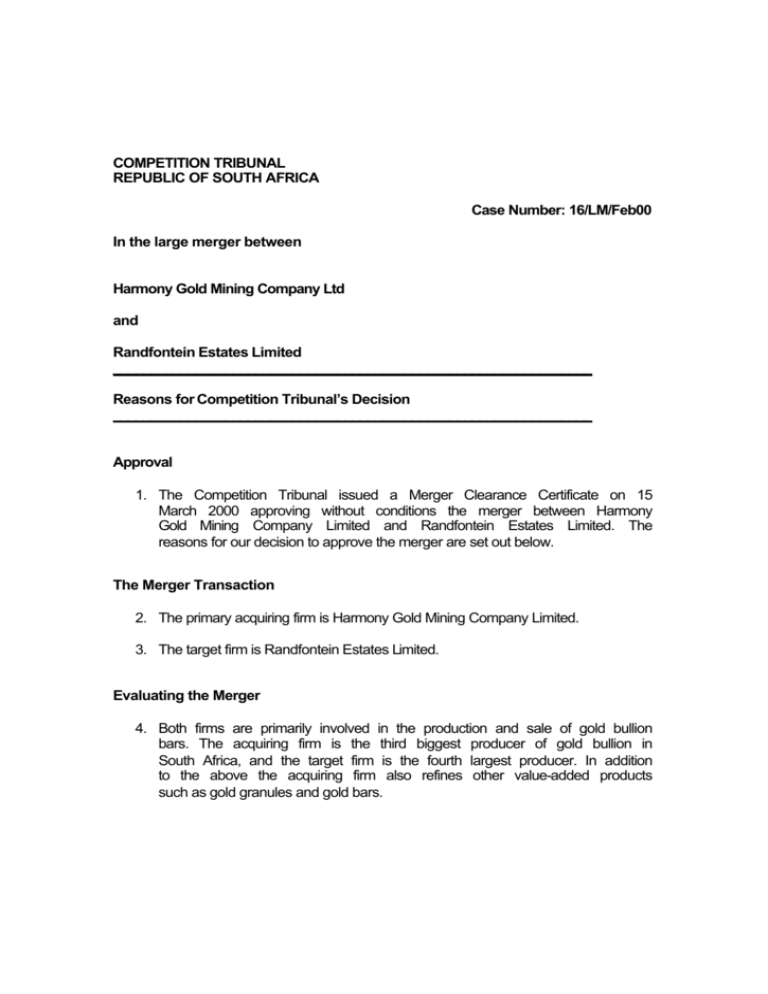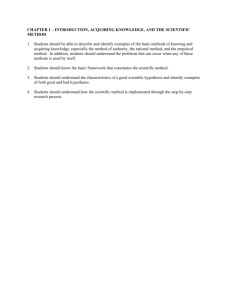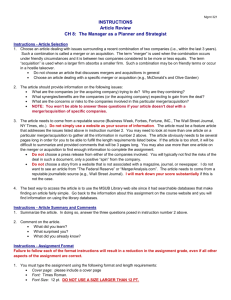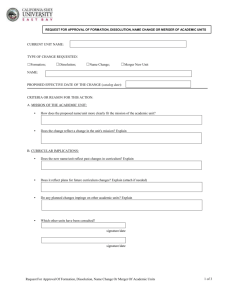16lmfeb00
advertisement

COMPETITION TRIBUNAL REPUBLIC OF SOUTH AFRICA Case Number: 16/LM/Feb00 In the large merger between Harmony Gold Mining Company Ltd and Randfontein Estates Limited ________________________________________________________________ Reasons for Competition Tribunal’s Decision ________________________________________________________________ Approval 1. The Competition Tribunal issued a Merger Clearance Certificate on 15 March 2000 approving without conditions the merger between Harmony Gold Mining Company Limited and Randfontein Estates Limited. The reasons for our decision to approve the merger are set out below. The Merger Transaction 2. The primary acquiring firm is Harmony Gold Mining Company Limited. 3. The target firm is Randfontein Estates Limited. Evaluating the Merger 4. Both firms are primarily involved in the production and sale of gold bullion bars. The acquiring firm is the third biggest producer of gold bullion in South Africa, and the target firm is the fourth largest producer. In addition to the above the acquiring firm also refines other value-added products such as gold granules and gold bars. 2 The relevant product/service market 5. The relevant product/services market is the sale of gold bullion bars. The relevant geographic market 6. The production and sale of gold bullion bars is an international market. Impact on competition 7. Although both firms are in the same product market, this does not give the merging parties market power, as the relevant geographic market is very wide. Moreover, the supply of gold bullion bars on the international market occurs at two levels; the sale of new production by producers and the sale of reserves by financial institutions. The acquiring firm and the target firm produce and sell new gold, while international central banks, the World Bank and the IMF have vast amounts of gold in reserve and sell on the international market as well. It is inconceivable that a single producer of gold can influence prices in the market. According to the report of the Commission the parties to this merger have a combined share of 2,44% on the international market for the new production and sale of gold. The sheer size of the market means that South African gold producers are essentially price takers. 8. The Tribunal therefore agrees with the Commission that this merger raises no competition concerns. Public interest considerations 9. In terms of the information given to the Tribunal by the acquiring firm and the Commission there are no substantial public interest concerns resulting from this merger. 10. It is envisaged by the acquiring firm that some employees of the target firm will lose their jobs pursuant to the merger. The acquiring firm intends to cut down on the costs of production at the target firm and the job losses will be a consequence of this process. It is estimated that about 60 (sixty) senior employees will lose their jobs. According to the information put before the Tribunal the staff to be retrenched are skilled professionals who do not require retraining. They are employees who should be able to find other jobs. The Commission received no objections to this merger from the trade unions representing employees of the merging parties. The only representation received from a trade union was to the effect that it was satisfied that the acquiring firm has acted in an open and transparent manner. Based on the above information the Tribunal agrees with the 3 Commission’s finding that there are no public interest concerns raised by this merger that warrant its prohibition. 14 April 2000 ____________________ N.M. Manoim Concurring: D.H. Lewis and P.E. Maponya Date







